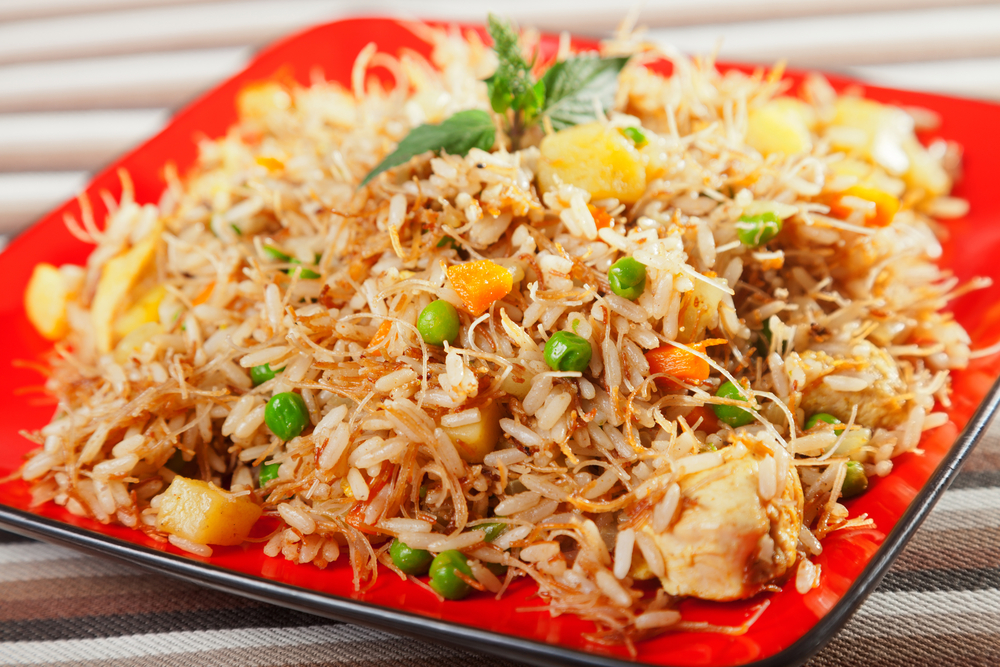The Heritage of Tanzanian Biryani
Biryani in Tanzania is a tale of culinary fusion, blending Indian influences with Swahili tastes to create a dish that’s uniquely East African. While the roots of biryani trace back to South Asia, Tanzania’s version has a distinctive flavor and method that sets it apart, showcasing the nation’s ability to absorb and enhance the culinary traditions of its trade partners.
Tracing the Origins of Tanzanian Biryani
Tanzania’s tryst with biryani began through its historic connections with traders from the Arabian Peninsula and the Indian subcontinent. The coastal city of Zanzibar, often referred to as the “Spice Island”, played a crucial role as a trading hub, leading to the exchange of not just goods, but also recipes and cooking techniques. The aromatic spices grown in the region found their way into the biryani pot, leading to a unique Swahili twist to the classic dish.
Essential Ingredients for Tanzanian Biryani
- 2 cups of basmati rice
- 4 cups of water or broth (chicken or beef)
- 1 large onion, thinly sliced
- 2-3 cloves of garlic, minced
- 1 inch of ginger, minced
- 2-3 tbsp biryani masala or a blend of cumin, coriander, cardamom, and cloves
- 1/2 cup yogurt
- 2 tbsp tomato paste
- 1 tsp turmeric powder
- 1 tsp red chili powder (adjust to taste)
- 2 tbsp cooking oil or ghee
- Salt to taste
- Meat (chicken, beef, or mutton) cut into pieces
- Optional: Saffron strands soaked in warm milk for color and flavor.
- Fresh coriander and mint leaves for garnishing.
Step-by-Step Cooking Instructions
- Preparation: Wash the rice and soak it for about 30 minutes. Drain and set aside.
- Browning Onions: In a large pot, heat the oil or ghee over medium heat. Add the onions and fry until they turn golden brown. Remove half for garnishing later.
- Meat Preparation: Add the ginger and garlic to the remaining onions in the pot and sauté until fragrant. Add the meat pieces, yogurt, tomato paste, biryani masala, turmeric, red chili powder, and salt. Cook until the meat is browned and the spices are well-blended.
- Rice Cooking: In a separate pot, boil the rice with salt until it’s 70% cooked. Drain the water.
- Layering: In the meat pot, once the meat is cooked, layer the partially cooked rice over the meat. If using saffron, drizzle the saffron-infused milk over the rice. Garnish with the reserved fried onions, mint, and coriander.
- Final Cooking: Cover the pot with a tight-fitting lid. You can place a heavy pan or tava (griddle) under the pot and cook on low heat for about 30-40 minutes. This method, known as ‘dum’, allows the flavors to meld.
- Serving: Gently fluff the biryani with a fork, ensuring the meat and rice are mixed. Serve hot with raita (yogurt dip) or a side salad.

Embracing the Full Biryani Experience from Tanzania
Tanzanian Biryani offers a delightful symphony of flavors and textures, symbolizing the island nation’s multicultural heritage. Whether you’re enjoying it during a festival, a wedding, or a regular weekend treat, Tanzanian Biryani serves as a flavorful journey through history and diverse culinary traditions.
Embark on a Tanzanian Culinary Expedition
Tanzania beckons with its vast culinary offerings, each dish resonating with age-old traditions and contemporary influences. From the highlands to the coast, Tanzanian cuisine mirrors its varied topography and rich cultural tapestry. As you experiment with these curated recipes, don’t let your journey end here. Our Tanzanian Cuisine Hub is your gateway to a more profound exploration. From indigenous cooking methods to the stories behind every ingredient, delve into the heart of Tanzanian gastronomy. Let’s celebrate the flavors, fragrances, and fervor of Tanzanian cooking. Stir your curiosity as you stir those pots and pans!
